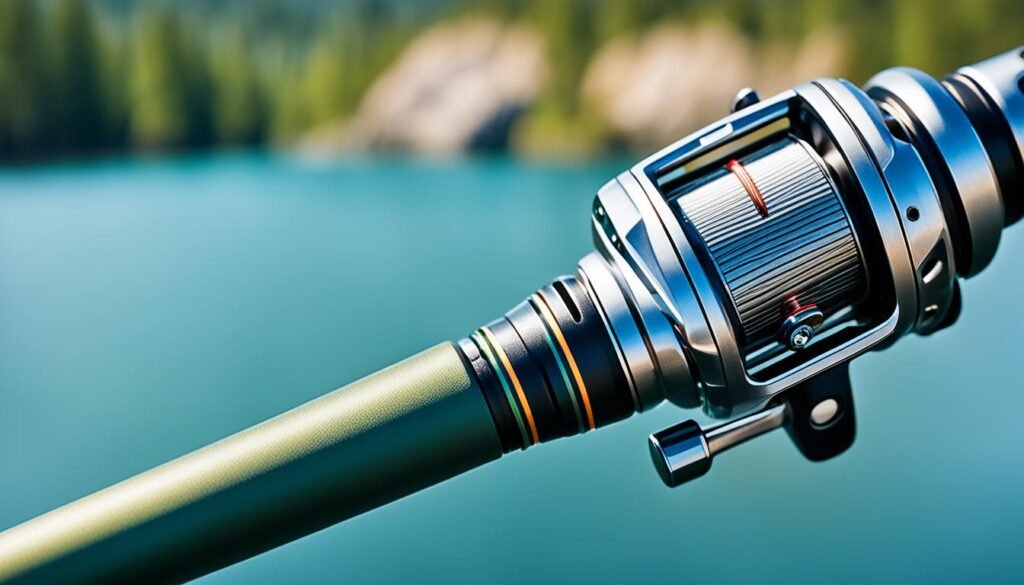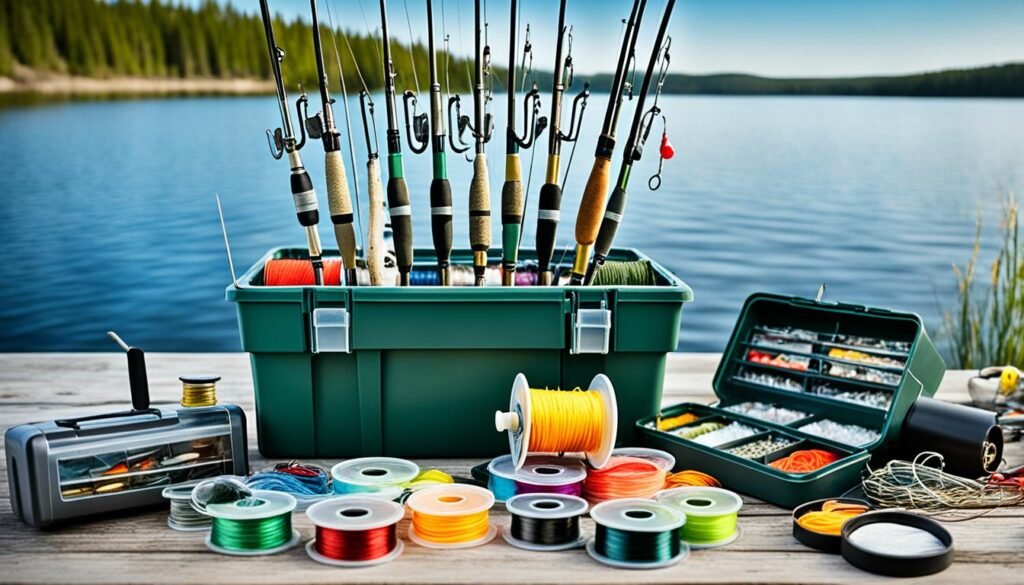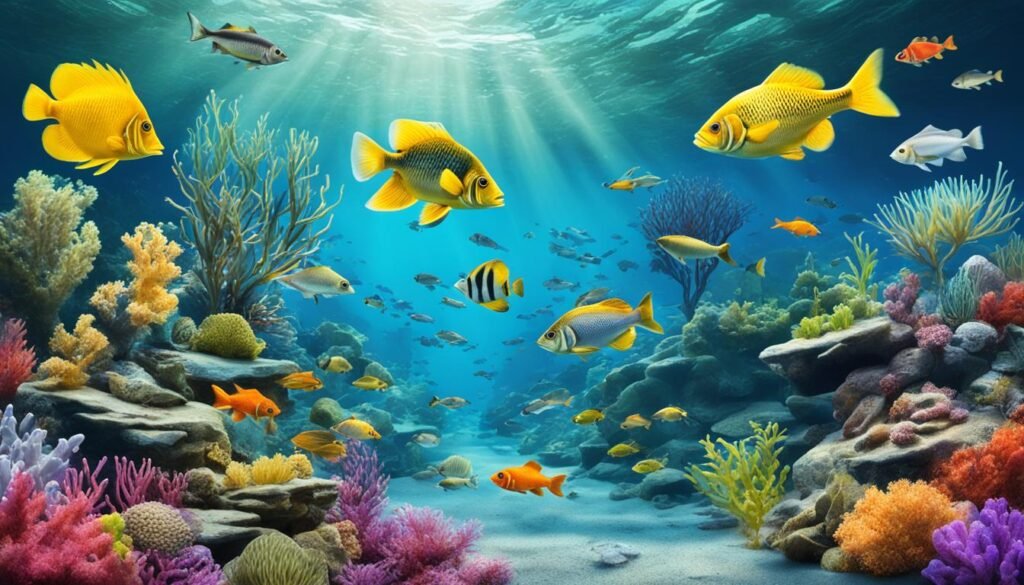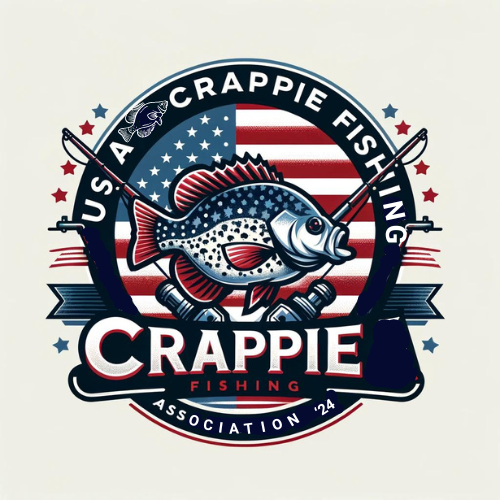Picture this: It’s a beautiful summer morning, and you’re standing at the edge of a serene lake, ready to cast your line. As you take a moment to soak in the peacefulness of the surroundings, you can’t help but feel the excitement of what lies beneath the surface. You know that today might just be the day you land that big catch.
But to make the most of your fishing adventure, it’s crucial to have the right gear by your side. Whether you’re a seasoned angler or just starting out, upgrading your fishing gear for lake success can make a world of difference in your overall experience and your chances of reeling in a trophy-worthy fish.
Imagine having a longer, more flexible fishing rod that allows you to cast your line further and with greater precision. Or how about a top-of-the-line reel that effortlessly reels in your catch with smooth precision? These essential upgrades can take your fishing game to new heights and ensure that you’re well-equipped for whatever lake success has in store for you.
But the upgrades don’t stop there. Consider investing in the best lures and baits that are specifically designed to entice the fish that inhabit the lake. With the right selection, you’ll have a greater chance of attracting the attention of those elusive trophy fish and bringing them to your hook.
And let’s not forget about the importance of choosing the right fishing line and hooks. A strong and durable fishing line can withstand the battles between you and your catch, while carefully selected hooks can increase your chances of a solid hookset.
So, before your next fishing trip to the lake, take the time to evaluate your fishing gear and consider these essential upgrades. With the right equipment in hand and a touch of luck, you’ll be well on your way to lake success.
Key Takeaways:
- Upgrading your fishing gear is crucial for a successful day on the lake.
- Invest in a longer, more flexible fishing rod and a high-quality reel for improved performance.
- Choose the best lures and baits to attract the fish you’re targeting.
- Select a strong and durable fishing line and the right hooks for optimal hooksets.
- Upgrade your fishing gear to increase your chances of a great catch and a memorable fishing experience.
Must-Have Fishing Tackle Items for Lake Success
When it comes to fishing on the lake, having the right tackle items is crucial for a successful day. The right fishing gear can make all the difference in attracting and catching fish. Whether you’re a seasoned angler or a beginner, here are some essential fishing gear recommendations that should be in your arsenal for lake fishing:
- Fishing rods: A high-quality fishing rod is the backbone of your fishing gear. Look for rods that are strong, durable, and suitable for lake fishing conditions. Brands like Shimano and St. Croix offer a wide range of options to suit different fishing styles.
- Reels: Pair your fishing rod with a reliable reel that matches your fishing technique. Spinning reels are popular for lake fishing due to their versatility and ease of use. Look for reputable brands like Penn or Daiwa for reliable performance.
- Lures and baits: A variety of lures and baits are essential for enticing fish in the lake. Opt for a mix of artificial lures like crankbaits, spinnerbaits, and soft plastics, as well as live or fresh baits like minnows and worms.
- Fishing line: Choose a fishing line that is strong, durable, and suitable for lake fishing conditions. Monofilament lines are versatile and widely used for lake fishing. Brands like Berkley and PowerPro offer excellent options.
- Hooks: Having a selection of hooks in different sizes is important for targeting a variety of fish species. Make sure to match the hook size to the bait or lure you’ll be using. Brands like Gamakatsu and Owner are renowned for their quality hooks.
- Weights and floats: Adding weights and floats to your fishing rig helps adjust the depth at which your bait or lure is presented in the water. Different weights and floats are available for different fishing techniques and conditions.
- Needle nose pliers: A good pair of needle nose pliers is essential for safely removing hooks from fish, especially those with sharp teeth or deep-set hooks. Look for pliers with a long nose and a built-in wire cutter for added convenience.
- Hook removers: Hook removers are handy tools for quickly and safely extracting hooks from the mouths of fish, reducing stress and injury to the fish. Choose a hook remover with a comfortable grip and a design that minimizes harm to the fish.
Each of these tackle items serves a specific purpose and can greatly enhance your fishing experience on the lake. Having the right fishing gear ensures that you are well-prepared and equipped to handle any fishing situation. So, make sure to stock up on these essential items before your next fishing adventure.
Choosing the Right Fishing Rod and Reel
When it comes to upgrading your fishing gear for lake fishing, selecting the right fishing rod and reel is essential. Consideration of factors such as strength, flexibility, and length will help you make the best choice. One popular option for fishing rods is graphite rods, known for their lightweight yet strong and durable properties. These rods offer the perfect balance for casting accuracy and sensitivity, providing an advantage in lake fishing.
Now, let’s delve into the various types of fishing reels and their suitability for different fishing preferences and water conditions:
Spinning Reels
Spinning reels are the most versatile type and are widely used in lake fishing. They are easy to handle, making them a great option for beginners. With a spinning reel, you can cast lightweight lures and baits with ease, making them a popular choice for targeting various fish species in lakes.
Baitcasting Reels
If you have intermediate to advanced fishing skills and prefer precision and accuracy, a baitcasting reel might be the right choice for you. These reels offer superior control, allowing you to cast heavy lures accurately and cover longer distances. They are perfect for targeting larger fish species such as bass and pike in lake fishing.
Trolling Reels
Trolling reels are specifically designed for trolling, a popular fishing technique used in lake fishing. These reels are known for their sturdy construction and high line capacity, allowing you to fish at different depths and cover larger areas of the lake. They are commonly used for catching species such as trout, salmon, and walleye in lakes.
Now that you have a better understanding of the different types of fishing rods and reels, you can make an informed decision based on your fishing preferences and the specific conditions of the lake you’ll be fishing in. Remember, choosing the right fishing gear is crucial for a successful and enjoyable fishing experience.
| Fishing Rod Type | Key Features |
|---|---|
| Graphite Rods | Lightweight, strong, and durable |
| Spinning Reels | Versatile and easy to handle |
| Baitcasting Reels | Precision and accuracy for intermediate to advanced skills |
| Trolling Reels | Sturdy construction and high line capacity for trolling |

Selecting the Best Lures and Baits
The right lure or bait can greatly improve your chances of attracting fish. While natural baits like goldfish and worms are effective, there is a wide range of artificial lures available that can also entice fish to bite. Here are some popular options for lures and baits that you can consider for a successful day of lake fishing:
1. Jigs
Jigs are versatile lures that can be used in various fishing conditions. They come in a variety of colors, shapes, and sizes, allowing you to match the natural prey of the fish you’re targeting. Jigs work by imitating the movement of injured baitfish, attracting predatory fish.
2. Spinnerbaits
Spinnerbaits are excellent lures for covering a large area of water quickly. They consist of a metal blade that spins as it is retrieved, creating flash and vibration to attract nearby fish. Spinnerbaits are effective for targeting predatory fish like bass and pike.
3. Crankbaits
Crankbaits are designed to imitate the movement of small fish or other prey. They have a diving lip that allows them to reach specific depths in the water. The wobbling action and the rattle inside the crankbait generate vibrations and sound that can trigger a reaction strike from fish.
4. Soft Plastic Baits
Soft plastic baits, such as worms, creature baits, and grubs, are popular choices for many anglers. These baits are available in a wide range of colors, sizes, and shapes, allowing you to mimic the natural prey of the fish you’re targeting. They can be rigged on diverse hooks, including Texas rig, Carolina rig, or drop shot rig, depending on the fishing conditions and your preferred presentation style.
5. Topwater Lures
Topwater lures are designed to float on the water’s surface and create commotion to attract fish. They imitate insects, frogs, or injured baitfish. Topwater lures can be very exciting to use, as you can see the fish strike on the surface. They are particularly effective in early mornings or late evenings when fish are actively feeding near the surface.
| Lure/Bait | Advantages | Target Fish |
|---|---|---|
| Jigs | Versatile, mimics injured prey | Bass, walleye, pike |
| Spinnerbaits | Covers large area quickly, attracts predatory fish | Bass, pike, musky |
| Crankbaits | Imitates small fish, generates vibrations and sound | Bass, walleye, trout |
| Soft Plastic Baits | Wide variety, mimics natural prey, versatile presentations | Bass, panfish, catfish |
| Topwater Lures | Creates surface commotion, exciting strikes | Bass, pike, musky |
When selecting the best lure or bait, consider the size of the fish you’re targeting, the fishing conditions, and the behavior of the fish in the lake. Experiment with different lures and baits to determine what works best in your specific fishing situation. Additionally, it’s important to check the fishing regulations in the lake you’re fishing in to ensure that your chosen lures and baits are allowed.
Remember, the right lure or bait can make a significant difference in your fishing success. Be prepared to adapt and try different options, and you’ll increase your chances of landing a prized catch!
Choosing the Right Fishing Line and Hooks
When it comes to lake fishing, selecting the appropriate fishing line and hooks is crucial for a successful angling experience. The fishing line serves as a vital connection between your rod and the bait or lure, while hooks play a pivotal role in securing your catch. Understanding the different options available and how they can best suit your needs is essential in maximizing your chances of a fruitful day on the water.
For beginners and seasoned anglers alike, monofilament lines are a popular choice. These lines are known for their strength and durability, making them a reliable option for casting and reeling in fish. With their versatility and forgiving nature, monofilament lines provide a good balance between performance and ease of use.
When it comes to hooks, there is a wide variety of shapes and sizes available, each designed to match different types of bait or lures. Whether you’re using live bait, such as worms or minnows, or artificial lures like spinners or jigs, it’s crucial to select the appropriate hook size and style. Ensuring that the hook is compatible with your bait or lure will optimize your chances of attracting and hooking your desired fish species.
When using live bait, such as worms or minnows, a versatile hook design like the Aberdeen hook is often a popular choice. Its long shank allows for easy bait presentation and reduces the chance of the bait getting swallowed by the fish. On the other hand, for artificial lures like spinners or jigs, hooks with heavier gauge wire and sharper points, such as the wide gap or offset hooks, are preferable to ensure a secure hookup.
Remember, the choice of fishing line and hooks can greatly impact your success on the lake. By selecting the appropriate line for your fishing style and opting for hooks that complement your chosen bait or lure, you’ll increase your chances of landing that prized catch.

Summary:
- Choose a monofilament fishing line for strength and durability.
- Select hooks based on the type of bait or lure you’ll be using.
- Consider the hook size and style that aligns with your target fish species.
- For live bait, use hooks with a long shank like the Aberdeen hook for better bait presentation.
- For artificial lures, opt for hooks with heavier gauge wire and sharp points like the wide gap or offset hooks.
Enhancing Fish Habitat and Cover
Improving fish habitat and cover in a lake can attract more fish to specific areas, increasing your chances of a successful catch. By creating suitable spawning areas and refuge for fish, you can significantly enhance the fish population in your fishing spot.
Adding gravel substrate is a simple yet effective way to enhance fish habitat. Gravel provides a natural environment for fish to spawn and lay their eggs. It also offers a hiding place for small fish seeking protection from predators. Consider adding a layer of gravel to the lakebed to create these favorable conditions.

Artificial fish cover is another valuable addition to enhance fish habitat in a lake. Structures like fish attractors, submerged trees, and rock piles serve as shelter for fish, providing them with protection and a place to hide. These cover structures attract baitfish, which in turn attract larger predatory fish. By strategically placing artificial fish cover, you can create hotspots for fish activity.
This habitat enhancement technique is particularly beneficial in man-made ponds that lack natural fish habitat. Such ponds often have limited hiding places for fish, making them less productive for fishing. By introducing gravel and artificial fish cover, you can transform these ponds into thriving fishing spots.
Remember to check local regulations and guidelines before enhancing fish habitat in a lake. Some areas may have specific rules regarding the use of artificial structures or gravel substrates. Always respect the environment and consult with local authorities to ensure your actions are appropriate and sustainable.
Fishing Techniques for Lake Success
To increase your chances of success on the lake, it’s important to employ effective fishing techniques. By utilizing the right techniques, you can maximize your catch and make the most of your fishing experience. Here are some popular fishing techniques that can help you achieve lake success:
1. Jigging
Jigging is a versatile technique that involves jerking or bouncing a weighted lure up and down to imitate the movements of prey fish. It is effective for attracting a variety of fish species, including walleye, bass, and pike. Adjusting the depth, speed, and action of your jigging can help you target different fish at various depths in the water column.
2. Drifting
Drifting involves casting your bait or lure and letting it drift with the natural current or wind. This technique is suitable for open water areas and can be effective for targeting fish that are actively feeding or cruising. Adjusting your drift speed and using appropriate bait or lures can help entice fish to strike.
3. Still Fishing
Still fishing, also known as bait fishing, involves casting your line and letting it sit in one spot until a fish bites. This technique is commonly used with live bait or stationary lures and is effective for targeting bottom-dwelling species such as catfish, carp, and panfish. Patience and careful monitoring of your line are key to success with still fishing.
4. Trolling
Trolling involves pulling your bait or lures behind a moving boat. This technique allows you to cover a large area of water and search for actively feeding fish. Trolling is commonly used with lures that mimic the swimming action of fish. Adjusting your trolling speed and depth can help you target different fish species and increase your chances of success.
Remember, each fishing technique has its advantages and can be effective depending on the type of water you’re fishing in and the fish species you’re targeting. It’s important to experiment with different techniques, adapt to the conditions, and observe the behavior of the fish to improve your chances of a successful catch.
| Technique | Fish Species | Advantages |
|---|---|---|
| Jigging | Walleye, bass, pike, etc. | Can be used at various depths |
| Drifting | Various species | Covers a large area of water |
| Still Fishing | Catfish, carp, panfish, etc. | Effective for bottom-dwelling species |
| Trolling | Various species | Covers a large area of water |
The Importance of Fish Attraction and Feeding
When it comes to fishing, attracting fish to a specific area can significantly increase your chances of a successful catch. One effective way to achieve this is by installing an automatic fish feeder near fishing access points. Fish feeders not only attract fish but also help to increase the number of fish in a waterbody.
What makes fish feeders particularly useful is their ability to attract specific types of fish, such as bluegill. These feeders dispense a controlled amount of feed at regular intervals, creating a reliable food source that fish can’t resist. With regular feeding, more fish are drawn to the area, increasing your chances of catching larger and more abundant fish.
An automatic fish feeder is an excellent addition to your fishing gear arsenal. Not only does it attract fish, but it also helps create a reliable fishing area. Novice anglers, in particular, can benefit from having a designated hotspot where they are more likely to find fish. This can boost their confidence, encourage a love for fishing, and foster a deeper connection with the great outdoors.
So, if you’re looking to enhance your fishing experience, consider incorporating a fish feeder into your gear. Watch as fish are irresistibly attracted to the feeding area, and enjoy the thrill of reeling in your next big catch.
The Benefits of Fish Feeders
| Benefits | Explanation |
|---|---|
| Attract fish to specific areas | Fish feeders release feed at regular intervals, creating an enticing food source for fish and drawing them to specific spots. |
| Increase fish population | Regular feeding with fish feeders can result in a higher number of fish in a waterbody, improving fishing opportunities. |
| Attract specific fish species | Some fish feeders are designed to attract particular species, such as bluegill, enhancing the chances of catching your desired fish. |
| Create reliable fishing areas | Fish feeders establish designated hotspots that novice anglers can rely on and increase their chances of success. |
| Encourage passion for the outdoors | A reliable fishing area created by fish feeders can foster a love for fishing and forge a deeper connection with nature. |
Conclusion
Upgrading your fishing gear is crucial if you want to improve your chances of success on the lake. By investing in the right tackle items, choosing the appropriate rod and reel, using the best lures and baits, and employing effective fishing techniques, you can significantly enhance your fishing experience.
When it comes to fishing gear, quality matters. Upgrading to high-quality and durable gear will not only improve your performance but also ensure that your equipment lasts longer. Investing in a reliable fishing rod and reel combo, along with a variety of lures and baits, will give you the versatility you need to adapt to different fishing conditions and target different fish species.
Furthermore, don’t forget about the importance of creating the ideal fish habitat. Enhancing fish habitat and cover in the lake can attract more fish to your favorite fishing spots. Adding gravel substrate, artificial fish cover, and even utilizing fish feeders can greatly enhance your chances of a rewarding catch.
So, take the time to evaluate your fishing gear and make the necessary upgrades. With improved gear and a strategic approach, you’ll be well-equipped to achieve lake success and enjoy a more productive and enjoyable fishing experience.
